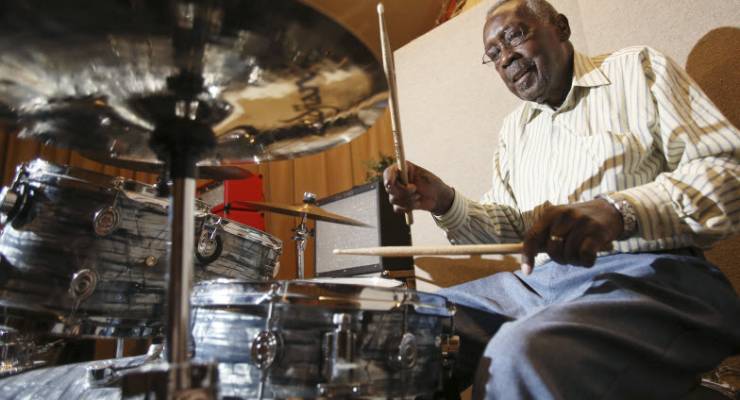
Clyde Stubbefield
In a different world, Funky Drummer might have been largely indistinguishable from any number of breezy, extended summer jams churned out by James Brown and his band, the JBs, during the late 1960s and early 1970s. A delight for connoisseurs, a pleasure for casual fans, and, at the very least, filled with the largely incomprehensible instructions to his band that make up everyone else’s James Brown impression. I say largely, because there is one particularly distinct piece of commentary at around five minutes in:
“When I count to four I want everyone to lay out and let the drummer go …”
At 5.31, the greatest “ah-one-two-three-four” in history hits, and the song becomes immortal.
You’ve likely never heard of Clyde Stubblefield, who played drums for James Brown on several hits, and died of kidney failure on February 19 this year, but if you like popular music, he has made your life better. In those 21 unaccompanied seconds, the combination of lead heavy kick drum and feather-light ghost notes on the snare (as well as Brown’s grunts, laughs and commentary) sets the template for much of the dance music that would follow.
Most obviously, it ripples through every era of hip-hop — from Grandmaster Flash and Public Enemy to NWA and LL Cool J, to Dr Dre, Jay-Z to Lupe Fiasco and Eminem. Indeed, it was present at hip-hop’s birth in the street parties and break-dancing competitions of mid-1970s Bronx New York. The fixation on “breaks” grew from one particularly successful DJ’s insight into when the party peaked.
“DJ Kool Herc is credited as one of the first to realise that dancers would respond best to the parts of the records he played that just had drums,” Margie Borschke, senior lecturer at Macquarie University’s Department of Media, Music, Communication and Cultural Studies told Crikey.
Herc is considered the Godfather of hip-hop — he pioneered “the merry go round” DJing technique, by which he would extend the percussive soloing in a song — the break — by playing two copies of the same record, syncing them so their breaks would flow into one another and cutting between the two seamlessly. Soon, finding records that had great breaks became like currency to DJs. There was no snobbery in this process — a record could be by a quickie cash-in like The Incredible Bongo Band, an obscure English rock group like Babe Ruth, or even a misbehaving proto-boy band like The Turtles; if they had drums that sounded good, they were welcome to the party. But some records — like Funky Drummer — became practically mandatory.
“A certain point, as hip-hop evolved out of break dancing competitions and block parties, certain records — like Apache or Funky Drummer — it wasn’t just that you wanted to play them, you sort of had to,” associate professor of popular music at Sydney Uni Charles Fairchild told Crikey.
“It became a show of skill, but also a show of knowledge, a display that you belonged, you were part of the club. It was also the only fair way to judge a dance contest”
Even if you don’t like hip-hop — say you prefer modern alternative (nebulous and meaningless as that term is) like Blood Orange or The Raveonettes or straight pop, like George Michael’s hookfest Freedom 90. Or you like cartoon themes (The Powerpuff Girls), or even just really bad music (Ed Sheeran), you have heard the Funky Drummer break. Sampling website WhoSampled catalogues 1384 separate samples. I’m sure there’s many more. Hip-hop geek Edan put together an entire album where every single beat was from the same source. It is the Wilhelm scream of music. It has been chopped up, sped up and slowed down, re-ordered and filtered, but never fully beyond recognition.
So Clyde Stubblefield was a modestly remunerated session musician who changed popular music forever. Yet he died in relative obscurity. And, because Funky Drummer is credited solely to Brown as a writer, despite growing out of a jam session, when people paid for Funky Drummer, it went to Brown. Who owns the funky drummer break?
“It points to the fact that copyright law is a very inadequate way to regulate the concepts of composition and performance,” Borschke said. “Which in reality, as we know, involves a lot of collaboration and improvisation — it’s very rarely the product of a sole author.”
Even in the pantheon of iconic drum breaks, Funky Drummer stands apart. Apache, It’s a new day, It’s Your Thing are instantly recognisable, but most are consigned to a particularly historical moment and are now rarely used. Even Amen Brother — Funky Drummer‘s only competition for the most sampled piece of music of all time — will primarily be associated with the 1990s UK dance music for which it set the template (see: a lot of The Prodigy, David Bowie’s Little Wonder).
Part of what countless producers have paid for, clearly, is Stubblefield’s sensitivity and skill as a musician, the surgical precision of his hands. But just as often utilised are Brown’s coughs and hiccups and a huge part of Funky Drummer‘s appeal is also down to it’s now antiquated analog sound and Brown’s prowess as a producer. It’s not just played well — it sounds perfect.
“The innovation with these [early hip-hop DJs] was a kind of expert listening, the way they heard little bits of different records became part of the performance, which I don’t think we take seriously enough,” Borschke said. “So when you hear all the different ways they used Funky Drummer, you get to hear it the way they hear it.”
Stubblefield was just a jobbing musician who got paid by the night, and despite its place in popular music’s bloodstream, he personally didn’t care for Funky Drummer that much.
“I just played something, and that was it. But I didn’t like the song. I still don’t really get off on it,” he told Paste in 2014.
However ambivalent he may have been about it, Stubblefield helped create a sound that — through some kind of kismet, like the peculiar crackle of a your copy of a record, a voice inadvertently cracking, a perfectly timed whine of feedback, the gentle wheeze of fingers running along guitar strings — sprints directly from your ears to the hairs on your arm.
In his case, again and again and again.








Another example of a screwed over musician. Unsurprisingly only an Artist who fought for artists’ rights pitched in to help Clyde when he most needed it.
http://www.billboard.com/articles/news/7348492/prince-funky-drummer-clyde-stubblefield-medical-bills
Wow.
In one sense that break is completely unremarkable, it is just drumming as we know it, a bit like how Shakespeare is full of cliches, and dramatic devices we have seen before many times.
Thanks for the article.
Another reminder of just how much unheralded musical workmanship sits behind musical superstardom, how the workaday choices and graft of the unsung can be the difference b/w someone else’s smash hit career and obscurity. Some of the best music films of recent years have started to get at this: Love and Mercy, 30 feet from stardom, the always brilliant Classic Albums series…
Great article, more of this from this writer, please!
Worth adding the resurgence of mid-tempo Britpop guitar music and boy/girl group ballads in the nineties to that long list of hugely commercial genres grounded in Stubblefield’s hands-in-pockets shuffle-along, too…where would Spice Girls/Robbie Williams/Coldplay et al be without it…
https://m.youtube.com/watch?v=3wkuqRFXNvI
https://m.youtube.com/watch?v=luwAMFcc2f8
https://m.youtube.com/watch?v=r8OipmKFDeM
White English middle classers skinning black American musos for squillons? Who’d have ever thunk it…?!